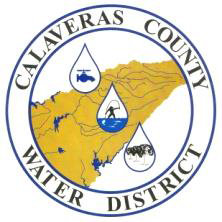San Andreas, CA…Of the many natural resources found in Calaveras County, water is arguably the most valuable, and protecting access to the water that originates here is critical to the county’s future. This has long been recognized by the Calaveras County Water District, which has been a faithful steward of the county’s greatest asset for the past 70 years. Thankfully, the people of Calaveras County have consistently supported these efforts.
Like the county, the District has grown over those decades and as of July 2016, it supplies water to about 21,000 people, local businesses, agriculture and other beneficial uses. It also provides about 11,500 people with wastewater service, and the vast majority of treated water is recycled and put to beneficial use, such as golf course irrigation.

Since its creation by the residents of Calaveras in 1946, CCWD has been charged with providing clean, reliable water for the needs of our community and, to that end, protecting and maximizing the beneficial use of water rights throughout the county. Over the years, CCWD has thoughtfully developed infrastructure to achieve its mission of serving the community. And, perhaps most importantly, this infrastructure has created an exceptionally drought-resilient water supply.
Of all the major infrastructure projects developed by CCWD, the North Fork Project was the most ambitious and has proved to be the most beneficial to the residents of Calaveras County. Almost 30 years in the planning and five years to construct (1985-1989) at a cost of $624 million, the North Fork Project was, at the time, the largest design/build project of its kind in U.S. history. Made possible through a partnership with Northern California Power Agency (NCPA) as project manager and operator and CCWD as owner and federal licensee, the project spans 60 miles of the upper Stanislaus River basin from an elevation of 6,700 feet to 1,099 feet, including two reservoirs, two powerhouses and miles of tunnels in between. Its backbone facility, New Spicer Meadow Reservoir, can store up to 189,000 acre-feet (AF) of pristine snowmelt. An acre-foot is enough water to meet the needs of about two families per year. More than 60 billion gallons of water can be released downstream to generate 259 megawatts (MW) (one megawatt supplies the yearly energy needs of about 750 families) of renewable hydroelectric energy each year. It also provides a reliable supply of extremely high quality water to meet the needs of thousands of residents and visitors along the Highway 4 corridor for human consumption, agriculture, fire protection and recreation.
Another crucial infrastructure investment is New Hogan Reservoir on the Calaveras River near Valley Springs. After flooding caused major damage to Stockton in the 1950s, the U.S. Army Corps of Engineers constructed New Hogan Reservoir in 1960, increasing the storage capacity of the prior 115,000 AF reservoir to 317,000 AF. In partnership with Stockton East Water District, CCWD helped finance the project to provide municipal and agricultural water supplies for our communities. Today, New Hogan supplies thousands of CCWD customers in the Valley Springs area with a drought-resilient supply of water for fire protection, agriculture and human consumption. In partnership with Modesto Irrigation District, this facility also produces renewable hydroelectric power (3.15 MW) that, like the North Fork Project, helps fund the work of the District.
In addition to Spicer and Hogan, the District owns and maintains White Pines Lake (250 AF) near Arnold, which serves as a wonderful recreation location and provides a drinking water supply for the community of Sheep Ranch. The West Point and Wilseyville communities are served by a 50 AF off-stream reservoir in West Point that stores Bear Creek water as well as water from the Middle Fork of the Mokelumne River that is received under contract with Calaveras Public Utility District from Schaads Reservoir.
For the past 70 years, CCWD has invested in the infrastructure to store and deliver water to communities across the county while defending the invaluable water rights that make that possible. And these are just a few of the many ongoing efforts to ensure communities throughout this county continue to have access to reliable water supplies for all their needs. Generations of hard work to protect the use of our most important natural resource paired with wisdom and foresight of our forbearers has created a water supply system that is resilient in even the most severe droughts.
In the next installment of this three-part series, find out why the State required CCWD customers to use less water even though local supplies and conditions were adequate to meet demand, and why local management of water resources makes the most sense.
Terry Strange is the President of the Calaveras County Water District Board of Directors. He can be reached at ccwddirectorstrange@volcano.net. The District holds board meetings that are open to the public at 9 a.m. on the second and fourth Wednesdays of each month at 120 Toma Court, San Andreas.



Now we have and issue with the water and the new pot cultivators.